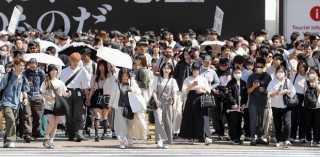Loading
Search
▼ Less Domestic Travelers Seen In Japan's Golden Week Amid Inflation
- Category:Tourism
The number of domestic travelers decreased during this year's Golden Week holiday period as many residents of Japan refrained from traveling far from home amid rising prices, private sector data showed Saturday.
Based on an analysis of data collected in the vicinity of 60 major train stations across Japan, 53 locations saw the number of domestic travelers drop during the holiday period when compared with a year earlier. This coincided with a surge in accommodation fees due to an increase in inbound tourism backed by the weaker yen.
It was the first Golden Week, a period from late April to early May that contains a number of national holidays, since Japan downgraded the legal status of the coronavirus to the same category as seasonal flu.
The holidays came as real wages decreased in March for the 24th consecutive month, the longest decline since comparable data became available in 1991.
The trend of people living in Japan refraining from traveling was prominent in rural cities, the analysis showed. But Fukui in central Japan was an exception and saw an increase of 8.9 percent in the number of domestic visitors compared with last year, the biggest surge among the major stations.
The city along the Sea of Japan coast is one of the stops on the extended Hokuriku Shinkansen bullet train line that opened in March.
Sapporo in Hokkaido, northern Japan, observed the largest drop at 15.8 percent, with major local cities Sendai and Nagoya also logging double-digit drops.
Kyoto and Tokyo's Shinjuku, while still popular tourist destinations for visitors from abroad, saw a fall of 7.7 percent and 5.7 percent, respectively.
The number of domestic travelers at the 60 sites totaled around 9.82 million a day on average, down 6.7 percent from a year earlier.
The figure tripled from the same period in 2020, when the COVID-19 pandemic started, while the number fell 26.0 percent from pre-pandemic levels in 2019.
Regarding the data analysis, Hideo Kumano, chief economist at the Dai-ichi Life Research Institute's Economic Research Department, said, "People seem to have opted for short-distance trips amid pressure to save money on leisure," adding people cannot drastically cut spending on electricity and food.
Kyodo News came up with the analysis based on population flow data collected by X-Locations Inc. a tech firm based in Tokyo, from GPS data on smartphone apps popular in Japan. It looked into the number of people within a 500-meter radius of major train stations.
Based on an analysis of data collected in the vicinity of 60 major train stations across Japan, 53 locations saw the number of domestic travelers drop during the holiday period when compared with a year earlier. This coincided with a surge in accommodation fees due to an increase in inbound tourism backed by the weaker yen.
It was the first Golden Week, a period from late April to early May that contains a number of national holidays, since Japan downgraded the legal status of the coronavirus to the same category as seasonal flu.
The holidays came as real wages decreased in March for the 24th consecutive month, the longest decline since comparable data became available in 1991.
The trend of people living in Japan refraining from traveling was prominent in rural cities, the analysis showed. But Fukui in central Japan was an exception and saw an increase of 8.9 percent in the number of domestic visitors compared with last year, the biggest surge among the major stations.
The city along the Sea of Japan coast is one of the stops on the extended Hokuriku Shinkansen bullet train line that opened in March.
Sapporo in Hokkaido, northern Japan, observed the largest drop at 15.8 percent, with major local cities Sendai and Nagoya also logging double-digit drops.
Kyoto and Tokyo's Shinjuku, while still popular tourist destinations for visitors from abroad, saw a fall of 7.7 percent and 5.7 percent, respectively.
The number of domestic travelers at the 60 sites totaled around 9.82 million a day on average, down 6.7 percent from a year earlier.
The figure tripled from the same period in 2020, when the COVID-19 pandemic started, while the number fell 26.0 percent from pre-pandemic levels in 2019.
Regarding the data analysis, Hideo Kumano, chief economist at the Dai-ichi Life Research Institute's Economic Research Department, said, "People seem to have opted for short-distance trips amid pressure to save money on leisure," adding people cannot drastically cut spending on electricity and food.
Kyodo News came up with the analysis based on population flow data collected by X-Locations Inc. a tech firm based in Tokyo, from GPS data on smartphone apps popular in Japan. It looked into the number of people within a 500-meter radius of major train stations.
- May 11, 2024
- Comment (0)
- Trackback(0)


